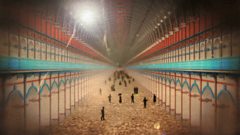
Glass Houses
Olivia Horsfall Turner explores how architects Joseph Paxton and Geoffrey Jellicoe planned to use glass to solve London's pollution and congestion problems.
Using her investigative skills to uncover long-forgotten and abandoned plans, architectural investigator Dr Olivia Horsfall Turner explores the fascinating and dramatic stories behind some of the grandest designs that were never built.
Technology has always been a driving force behind new ideas. Olivia explores how architects and designers have been inspired by the exciting possibilities presented by new technology to produce groundbreaking and controversial urban plans.
In 1855, visionary designer Sir Joseph Paxton proposed an ambitious plan to build a fantastic, futuristic ten-mile glass girdle circling the centre of London. It had only recently become possible to produce large sheets of cheap but strong plate glass and Paxton was inspired by its potential. With this exciting new technology at his fingertips, Paxton believed he could create a bright and pollution-free environment for Londoners as well as solve the capital's terrible congestion problems.
His spectacular glass 'Great Victorian Way' would connect the city to the West End, link rich and poor areas and cross the Thames three times. Contained in this magnificent glass structure were shops, houses, hotels, a pedestrian walkway, a road for carriages and eight lines of elevated pneumatic railway.
There was huge support for Paxton's scheme and Parliament passed a bill sanctioning construction, but the Great Victorian Way was never built. The 'Great Stink' took hold of London in 1858, spreading a cholera epidemic and so sanitation became the city's most pressing priority. Instead of creating a spectacular crystal boulevard the money was spent on a very different type of technology - the building of London's sewerage system.
A century later, London's congestion problems remained unsolved with the motor car having taken over roads designed for horse and carriage. In 1961, the architect Geoffrey Jellicoe proposed a solution directly inspired by Joseph Paxton's use of glass, in his radical new urban scheme for the green belt around London. Jellicoe took Paxton's idea of transforming the transport infrastructure even further, proposing a 'glass city' in which all cars would drive along rooftops, freeing the ground below for pedestrians.
With both these groundbreaking designs, Paxton and Jellicoe were seeking to harness technology to create bright and light cities, free of pollution and congestion, and utilising the most progressive forms of transport of the day.
Contributors include: Brett Steele, Eric Kuhne, Kate Colquhoun, Isobel Armstrong, Theodora Wayte, Lord Norman Foster, Charlie Burke, David Martlew, John Minnis, Hal Moggridge, Sir Geoffrey Jellicoe and Kathryn Moore.
Last on
More episodes
Previous
You are at the first episode
Next
See all episodes from Dreaming the Impossible: Unbuilt Britain
Clip
-
![]()
A glass loop around London
Duration: 01:40
Music Played
Timings (where shown) are from the start of the programme in hours and minutes
-
![]() 00:04
00:04Mr. Scruff
Get A Move On
-
![]() 00:25
00:25Max
Unheimlich Dringend
Credits
| Role | Contributor |
|---|---|
| Presenter | Olivia Horsfall Turner |
| Series Producer | Paul Murton |
| Director | Paul Murton |
Broadcasts
- Mon 12 Aug 2013 21:00
- Tue 13 Aug 2013 03:00
- Wed 14 Aug 2013 22:00
- Sun 27 Oct 2013 20:00
- Thu 13 Feb 2014 23:00
- Wed 20 Aug 2014 23:00
- Thu 10 Mar 2016 01:30
- Wed 10 May 2017 20:00
- Fri 12 May 2017 02:50
- Tue 20 Feb 2018 23:00
Post-War Architecture Collection
A collection of programmes examining the triumphs and failures of post-war architecture.


